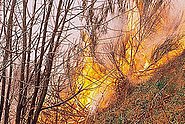
Forest fires ¶
Sustained periods of drought, which increase the risk of forest fire, have become increasingly common over the last thirty years. We systematically gather data of forest fires and develop methods and concepts to evaluate the risk and to learn about the fire ecology of tree species.
Contents ¶

Around ninety percent of forest fires in Switzerland are caused by human activity: careless behaviour or arson. However, periods of low precipitation and extreme drought, which have been occurring more frequently for several decades, increase the risk of fires.
The accumulation of biomass in the forest also contributes to the forest fire risk: Combustible dead wood, fallen leaves or undergrowth are no longer collected, but accumulate on the forest floor. As a result, fire can spread very easily, especially during long periods of drought.
Most frequent in Ticino ¶

Forests in Switzerland burn most frequently on the southern side of the Alps, i.e. in Ticino and in the south-facing Grisons valleys - typically in spring. At this time, it is driest there, there is often a foehn and the deciduous trees do not yet have any leaves to protect the ground from the drying rays of the sun.
Forests in the central alpine valleys, especially in the Valais, burn somewhat less frequently - but on average 28 times a year since 2000. In recent years, there have also been more forest fires in the rest of northern Switzerland, but they remain small at present.
Being prepared against forest fires ¶
The forest fire database SwissFire, a cooperation project with the Federal Office for the Environment, allows us to systematically record all forest fires in Switzerland. This database serves as the basis for forest fire management: fire prevention, planning of technical firefighting and optimisation of the firefighting strategy.
A central aspect of the management is the daily assessment of the forest fire risk. Our early warning system FireNiche helps the authorities to assess it.
We also monitor how forest areas affected by fire react: How quickly does life return and how does biodiversity change? And we investigate what consequential risks arise after a forest fire, such as a reduced protective function of the forest against rockfall, erosion or superficial landslides.
Related Topics ¶
Contact ¶
Research Group








